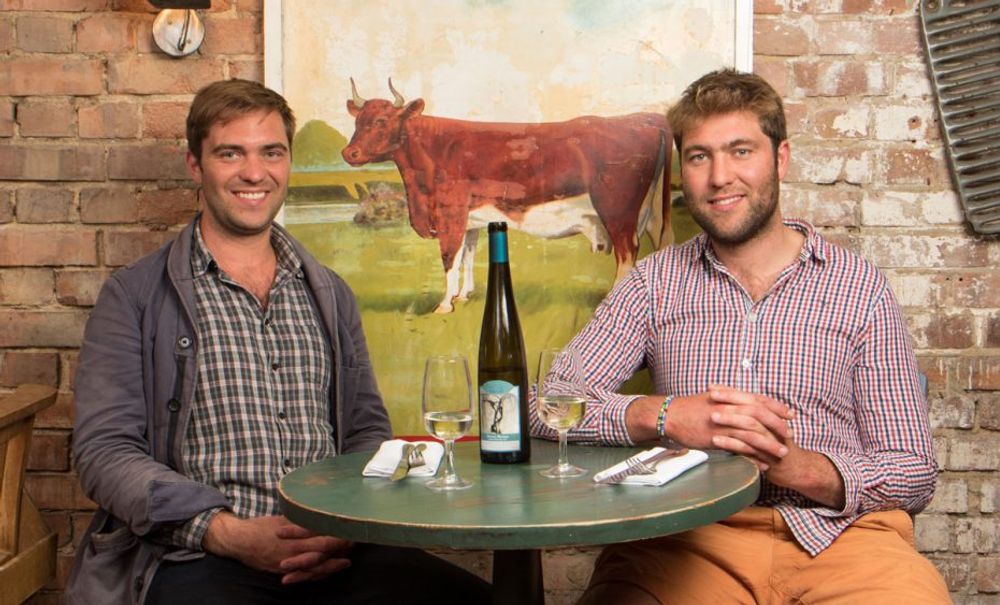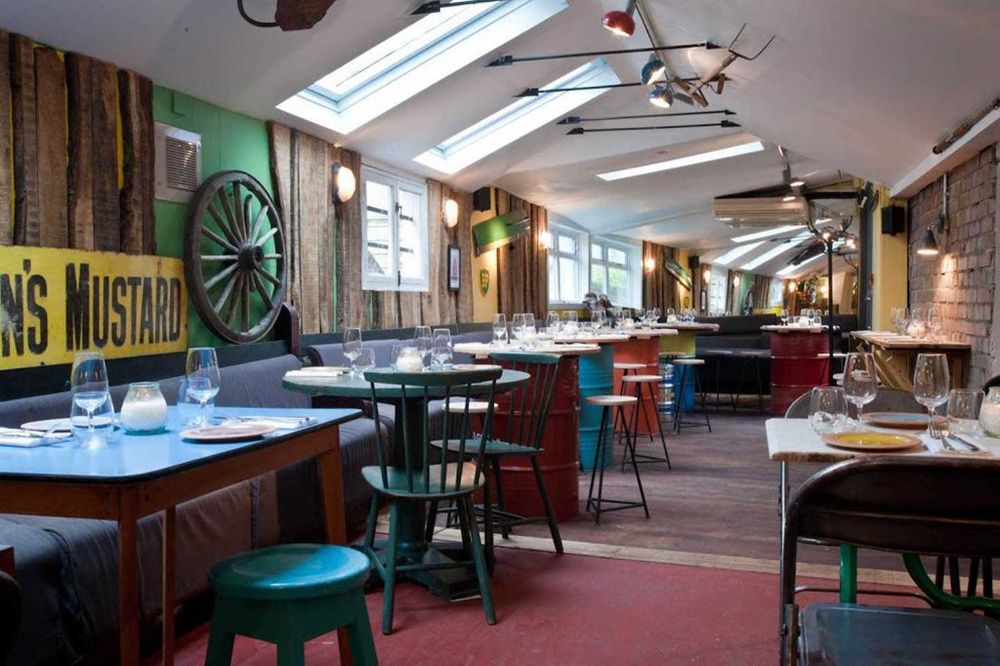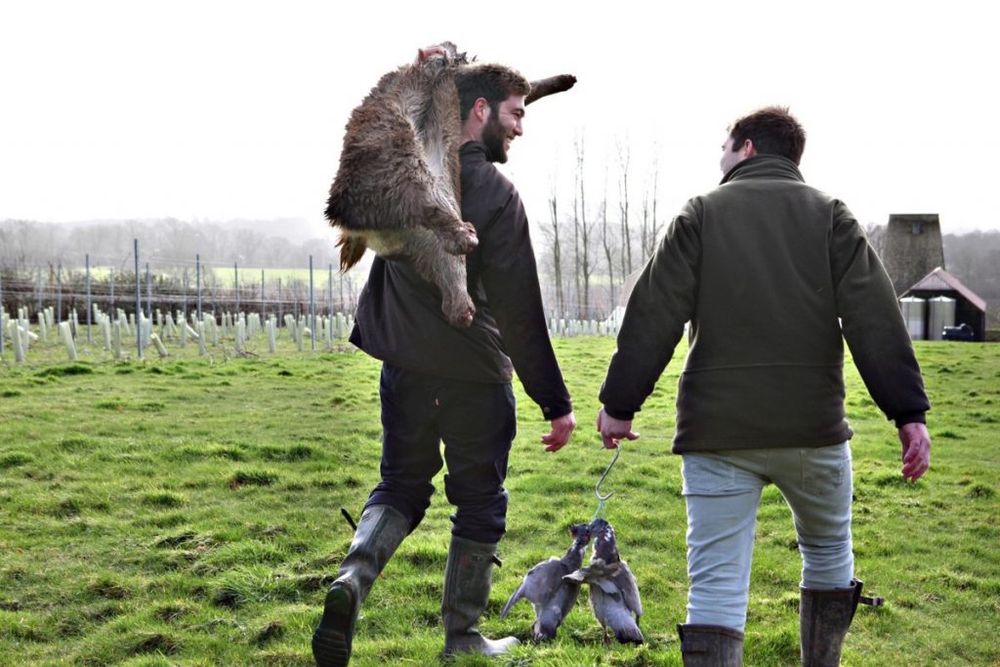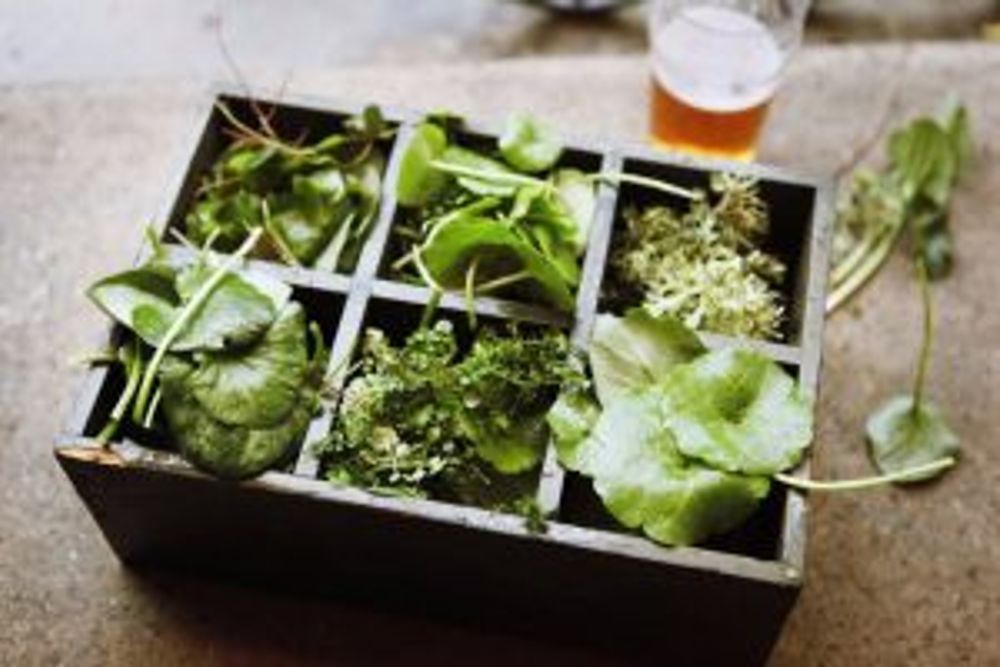The Nutbourne restaurant group is as self sufficient as you can get with the Gladwin family working together to make their own wine, rear their own meat and even going foraging for much of the local produce that ends up on the menu.

In a rare quiet moment: Richard and Oliver Gladwin
Provenance of their food and drink is something today’s consumers take more seriously than ever. Be it their weekly supermarket shop or dinner at their local restaurant, consumers are increasingly aware and interested in where their food comes from and how it is raised and produced.

The Shed: the Gladwins first restaurant in Notting Hill
And this is something which the London-based Nutbourne restaurants, owned by the Gladwin family, are able to assure their customers of more confidently than most.Not only does the award-winning family vineyard Nutbourne in Sussex supply much of the wine to its restaurants, but their neighbouring farm is the major source of most of the meat that appears on the menu.
Not only that, but the restaurants’ ethos is very firmly based on sourcing locally produced, seasonal produce, much of which is foraged in the countryside near the vineyard by the brothers themselves.
Their three restaurants in the mini chain include The Shed in Notting Hill which was opened in 2012, Rabbit on the Kings Road which opened its doors two years later, and last year Nutbourne in Battersea completed the trio.
A family affair
The Gladwins senior – Peter and Bridget – still run the family vineyard where they brought up their three sons in an idyllic childhood in the Sussex countryside– think Swallows and Amazons meets the Famous Five – all messing about in boats and running wild.
Eldest son Richard, who is the managing director overseeing the day to day running of the business, honed his hospitality skills in several top restaurants and worked in vineyards overseas, before embarking on his own project.

That’s the Sunday roast sorted then…
The family farm which rears pure bred sheep, cattle and pigs is run by youngest brother Gregory, and supplies the restaurants with the vast majority of its meat, with the exception of some pork.
Oliver, meanwhile, is the middle sibling, co-owner and head chef who works his magic with his innovative menus and focus on fresh, local meat and produce. After graduating from Leith’s cookery school in 2008, he worked for a number of prestigious restaurants including Launceston Place and the Oxo Tower restaurant.Enthused by his love of the countryside, he then went on to work with Hugh Fearnley Whittingstall, the chef and campaigner who has done much to popularise the concept of farm to fork eating with minimal waste.
The wild side
Inspired by what he learned at Whittingstall’s River Cottage, Oliver and Richard opened the Shed in 2012, with foraging and seasonal, sustainable cooking as its main ethos. “It was really Oliver who cracked the nut and opened us up to the concept of wild food,” says Gladwin, who often sets off on foraging missions in Sussex, picking whatever is growing at the time, and which can be used in the restaurant.
“It’s a great way to get out into the countryside and clear your head,” he says. “You need to know your spots, and where certain things grow. Wild garlic is abundant at this time of year, and blackcurrant blossom, which has a really pungent aroma, is perfect for making steeped cocktails.”

Produce picked direct from the Gladwin’s farm and surrounding hedgerows
Other produce which the brothers seek out in the lush Sussex hedgerows include pennywort, groundleaf, meadowsweet, all sorts of berries such as rowan berries, rosehips and blackberries, as well as mushrooms – though the latter is strictly reserved for personal consumption, with Gladwin not prepared to dice with the chance of poisoning his customers. “Definitely not worth the risk,” he laughs.
The Gladwins’ second restaurant, Rabbit, has already received widespread critical acclaim for its wild food and emphasis on sustainability. And since opening late last year, Nutbourne, which occupies the site of the former Ransome’s Dock restaurant in Battersea, has already garnered a loyal fan base with its all-day dining concept.
Working day in and day out with family could prove difficult for some, but Gladwin says that with each family member having such clearly defined roles, this is not something that has ever been an issue. “The nice thing is that they all work as separate departments; the farm runs as its own business, though obviously there is a relationship between the two businesses. We are all great mates. We have our own responsibilities but can ask one another for help.”
Family wine

As English as they come…Nutty sparkling wine
The vineyard, near Pulborough has 26 acres planted with vines, and produces both still and sparkling wines. One of the early pioneers of the English wine movement, wine grapes were first planted at Nutbourne in 1980, and it has been owned and managed by the Gladwins since 1991.
“English wine wasn’t what it is today when we started out,” points out Gladwin. “We’ve had 25 vintages to perfect and refine our wines.”
Nutbourne has an ideal wine growing environment with a warm microclimate protected by the South Downs, gentle, south facing slopes and the same fertile soil as France’s Champagne region.The vineyard has developed and expanded as English wine has come of age and now seven varietals are grown at Nutbourne, including Bacchus, Huxelrebe, Reichensteiner and Schönburger, Pinot Noir for red, sparkling blends and rosé, and both Chardonnay and Pinot Blanc.
All of the wines are made from grapes grown on the estate, and every part of the winemaking process takes place on site in the company’s state of the art winery.
The vineyard produces around 40,000 bottles a year, and nine different wines, including one red, a Pinot Noir, a rose, three sparkling wines – Sparkling Nutty Brut, Nutty Blush and Nutty Wild, the latter a new addition to the range and made only from Pinot Noir and at 10 % naturally lower in alcohol.
Sussex Reserve, a field blend of Bacchus, Huxelrebe and Reichensteiner grapes is the company’s best seller, while the single varietal Bacchus, an unoaked Chardonnay and Hedgerow, an off-dry blend of Schönburger and Bacchus complete the still white wine portfolio.
Worldwide list
Gladwin, who has worked in several start up restaurants including Bunga Bunga in Battersea, has also had hands on experience working in vineyards in Napa Valley, New Zealand and Champagne before launching The Shed.He is responsible for putting together the restaurants’ wine list, which not surprisingly prominently feature Nutbourne’s wines.
Gladwin says he likes to include a good selection of some of the classics which his customers expect to find on the wine list and which represent the best wines from those countries, including an Australian Shiraz, a New Zealand Sauvignon Blanc, a South African Chenin Blanc and a French Pinot Noir.“But you can only get so far with that approach,” he says. “You then need to take price points into consideration, and what people are prepared to pay.”
“I believe that even a small restaurant like ours needs to cater to our international customer base,” he says. “Here in Notting Hill we have Australians meeting Americans, Argentinians over for the polo, Italians entertaining South Africans. “
Gladwin likes to shake up the wine list on a regular basis, tweaking his selection depending on a number of factors, not least of which is availability.“Recently my Aussie Shiraz ran out, and I needed a New World representative on the list, so I did a swop and put a chunky Chardonnay on from Australia, and a better value Shiraz from South Africa. At £60, the Chardonnay is not going to fly off the list, but it’s there for people who want it.”
The wine list covers the gamut of price points from the house white wine, starting at £22, right up to a £350 Chateau Palmer at the top end.
While Nutbourne offers the widest range of wines, with 200 bin ends, The Shed and Rabbit’s wine lists are more concise. They both offer 14 reds, 14 whites, two English sparkling, one French sparkling and a rosé, along with a Champagne, and all are available by the glass.
English over Prosecco

The Gladwins have making English wine since 1991
Despite the popularity of Prosecco, Gladwin hasn’t been tempted to include the Italian sparkler on any of his lists. “Lots of people try and sell me Prosecco, but I’m just not interested,” he says. “I think there are some very good Proseccos out there, but there are too many very bad varieties. Have English sparkling wine instead! The whole concept of the restaurants was based around the vineyard, so I feel we would be diluting that by offering Prosecco.”
However, he does include a Champagne on his list, a blanc de blanc from Lagache, a small Champagne house near Epernay where he worked for a while. “Some people just won’t drink anything but Champagne,” he says, a good reflection of the type of wealthy, international customers who frequent The Shed.
Gladwin, a big fan of classic French wine, has recently been buying Burgundy and Bordeaux en primeur, with considerable success. “I recently bought some real goodies, 200 cases of Burgundy, which are now ready to drink.I bought it for about £6 pre-duty, which turns out to have been a great investment, because the winemaker has since been recognised as the best new young winemaker in Burgundy for the ’15 vintage. I’m now sitting on this wine, and have to decide what to do with it. I want to be able to offer our customers a good white Burgundy around the £40 price point, as that’s what I want when I eat out. Our customers are getting great value, as we’re selling it for around £40, while I could mark it up to £60 if I wanted to. ”
Gladwin doesn’t employ sommeliers, though all staff are trained in wine and they hold regular tastings for staff. “We haven’t gone down that route, we just don’t have the space for another body, for one thing,” says Gladwin.
Foraged cocktails

A cocktail worth foraging for…
But it’s not all about the wine. A speciality of the Nutbourne group are their steeped cocktails, which are made by marinading a variety of foraged fruits and herbs such as rosemary and cucumber, orange, cherries and pears in a distilled grain spirit, produced by Suffolk-based Adnams. “We do an amazing cherry variety, which releases a fantastic almond flavour from the stone,” Gladwin enthuses. “The longer you leave it, the better the flavour.”
The cocktail list reads like a celebration of the English countryside, packed full of fragrant, aromatic herbs and plants, with mouthwatering concoctions such as Pollination – a chamomile infused gin with Limoncello and honey; Bittersweet Symphony, an infusion of Adnams Gin, rhubarb, Earl Grey and tonic water, or Equinox – lemon verbena vodka with elderflower, pear and ginger.
The very British menu is similarly inspired by the land, with dishes such as gin cured chalk stream trout, with orange, dill and seed cluster; rare roast beef carpaccio, with mustard mayo, watercress and pickled rapeseeds; slow roasted shallot, caper and anchovy tarte with samphire; or chestnut mushroom carpaccio, Quicke’s goats cheese, chilli, truffle and chervil.
As to the future, Gladwin says he is “always” on the lookout for a suitable venue for their next outlet, and is currently scouting the well-heeled streets of Mayfair and Soho in a low key way. But finding the perfect venue isn’t easy, he says. He doesn’t want a huge outlet, but prefers the “cosiness” of the likes of Rabbit, which has 45 covers.
Whatever he comes up with he has the reassurance of his full family support behind him.































